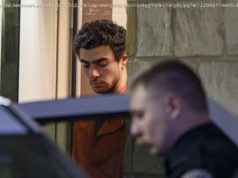MINNEAPOLIS (AP) — Gov. Tim Walz faced the biggest crisis of his political career when Minnesota’s two largest cities erupted in protests and riots after a white Minneapolis police officer killed George Floyd.
Gov. Tim Walz faced the biggest crisis of his political career when Minnesota’s two largest cities erupted in protests and riots after a white Minneapolis police officer killed George Floyd.
The Black man’s murder in 2020 sparked a nationwide reckoning over racial discrimination and police misconduct. His death, and its complicated aftermath, tested Walz’s leadership at one of the state’s most consequential moments.
What the governor did — or failed to do — during and after the violence in Minneapolis and St. Paul drew sharp criticism from Republicans in Minnesota. Nor did it satisfy some progressives who had urged him to take bolder steps to remake policing in the state. Walz’s defenders say he did an exemplary job under unprecedented circumstances.
Four years later, on the national stage as the Democratic nominee for vice president, Walz is facing similar questions and criticism: Republicans are calling him a left-wing radical who was too slow to act and some progressives are saying he was not radical enough in addressing police abuses.
A review by The Associated Press — based on government documents, consultant reports, news accounts, video and audio recordings, as well as interviews with families, activists, lawyers and public officials — paints a nuanced picture of how Walz handled the challenge. As a relatively new governor, he tried to balance the competing pressures and interests of local and federal officials, including then-President Donald Trump, while navigating the dangers posed by fast-evolving protests and riots taking place amid a deadly global pandemic.
“Sitting on the sidelines and critiquing, that’s not what being governor is. It’s making the hard decisions at the time,” Walz said during a gubernatorial debate in 2022.
He defended how local, state and federal authorities worked together, and said it should serve as model for other states. “I’m proud of Minnesota’s response; I’m proud of Minnesota’s first-responders who were out there, from firefighters to police to the National Guard, to citizens that were out there,” he said.
Floyd was killed on May 25, 2020, Memorial Day. Bystander video of his dying cries of “I can’t breathe” spread quickly, stoking outrage. The protests were mostly peaceful at first, albeit with some vandalism and clashes with police, as leaders struggled to balance the free-speech rights of protesters against the need to protect public safety.
Major looting started on May 27, two nights later. A Target store was plundered. An auto parts store and several other businesses were torched. The police chief asked the mayor to seek help from the National Guard. Minneapolis Mayor Jacob Frey would later say the governor hesitated, an accusation that Walz would deny.
Walz, a 24-year National Guard veteran, approved a limited activation on May 28 to protect firefighters and the State Capitol complex, and declared a peacetime emergency, though he continued to leave most of the response in the hands of local authorities.
The destruction only worsened that night. Protestors took control of the 3rd Precinct station, which soon caught fire and was destroyed. Guard troops did not arrive at the police station until several hours later, in the early hours of May 29.
That day, Walz criticized the “abject failure” of the city’s response.
Start
United States
USA — Criminal Sharp divisions persist over Walz's response to the riots that followed the...






